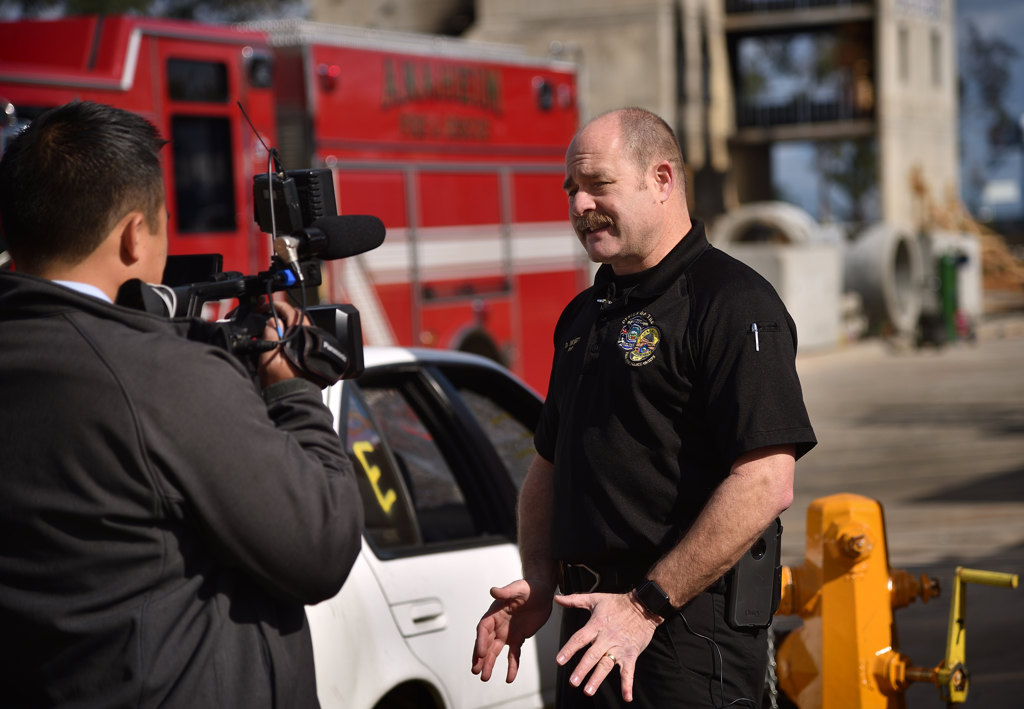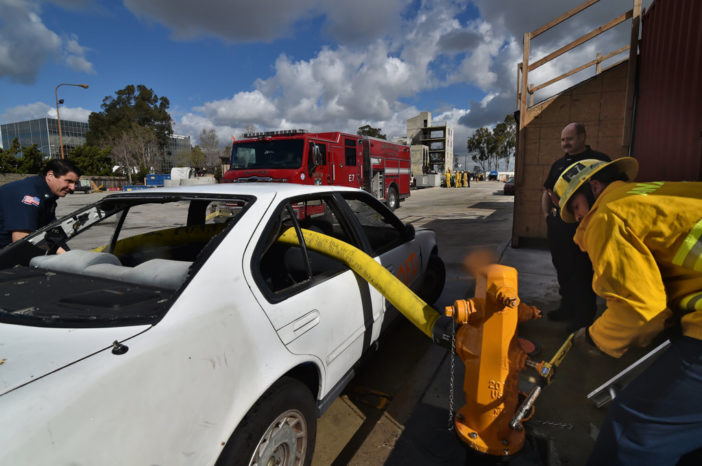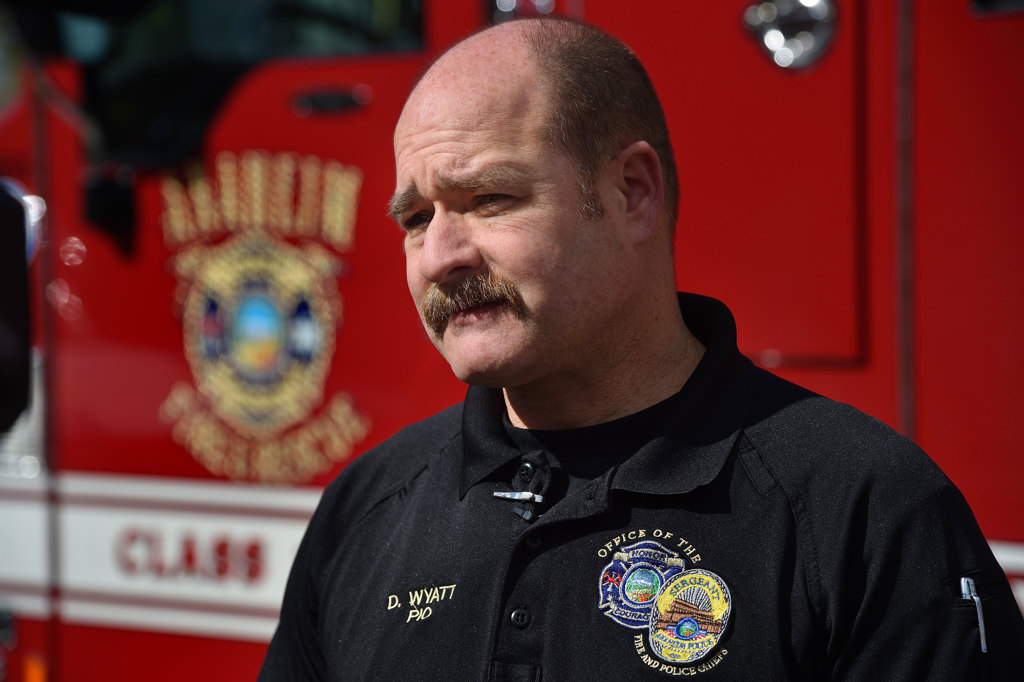In the fire service, kinks in hoses that restrict water flow possibly can mean the difference between a structure fire that ends successfully, without loss of life and minimal damage, or one that ends tragically.
When Anaheim Fire & Rescue crews rolled to an apartment fire at 6:22 a.m. on Feb. 26 in the 1100 block of N. West Street, they found a Nissan Altima parked directly in front of a fire hydrant, restricting firefighters’ access.

AF&R Firefighter/Paramedic John Fraumeni demonstrates how a firefighter can break a window of a car during an emergency. Photo by Steven Georges/Behind the Badge
It was the only fire hydrant on the street.
Knowing the fire was active and there were people in the apartment, AF&R Firefighter Engineer Nolan Karns made the split decision to use a tool to break through the car’s rear windows and run the hose through the car, keeping the hose as straight and unrestricted as possible.
That action, which AF&R posted about on social media to educate the public about the importance of not parking in front of hydrants, allowed firefighters to limit fire damage to the kitchen and prevent the blaze from spreading throughout the apartment and, possibly, three others in the two-story, four-unit building — as well as to nearby businesses.
The post went viral, with over 2 million hits to AF&R’s social media channels and inquiries to the agency from as far away as Italy and Holland, said Anaheim PD Sgt. Daron Wyatt, who also serves as public information officer for AF&R.
Most comments were positive, but some criticized AF&R, wondering why firefighters didn’t run the fire hose under, over, or around the car — or have the car towed.
“Some people even alleged we were being vindictive for running the hose through the broken windows,” Wyatt said.
On Friday, March 8, AF&R personnel staged a demonstration at the North Net Training Facility for an educational video to demonstrate why going under, over, or even around the car just doesn’t work. ABC7 was on hand and did their own segment on the demonstration.
“We were not trying to humiliate anyone,” Wyatt said. “We were just trying to educate the public.”
He added: “We did not have time to negotiate any other means to move that car. We had to go through the (car) windows and get in and save lives, and that’s what we did — and that’s what we’ll do in the future if faced with the same fact pattern.”

AF&R Firefighter/Paramedic John Fraumeni unthreads a firehose from a hydrant during a demonstration Friday, March 8, at the North Net Training Facility in Anaheim.
Photo by Steven Georges/Behind the Badge
Fire damage to the apartment was limited to an estimated $80,000, when it easily could have ballooned beyond $500,000 if the fire had ripped through the entire four-plex, AF&R Battalion Chief Tim Adams said.

AF&R PIO Sgt. Daron Wyatt talks to ABC7 about why firefighters had to break a car’s windows recently to run a hose through it to knock down an apartment fire.
Photo by Steven Georges/Behind the Badge
People block fire hydrants all the time with their cars, Adams said. But he said it’s rare when firefighters find a car blocking a hydrant when they arrive at a fire.
“I honestly think people are more worried about getting a ticket than blocking firefighters’ access to a hydrant,” Adams said.
On such calls, “Time is of the essence, big time,” says AF&R Firefighter Engineer Lacee Valente, a paramedic engineer with extensive training in driving engines and running hoses. Valente participated in Friday’s demonstration at the North Net Training Center in Anaheim.
State vehicle code requires that cars park at least 15 feet away from a fire hydrant, but cities can reduce the distance if they put up signs or paint the curb to indicate the restricted space. In Anaheim, the requirement is 7 feet 6 inches. Exceptions to the rule are if there is a licensed driver sitting in a car who can move the car immediately if needed, or if the vehicle is owned by the fire service and is clearly marked as such.

AF&R Firefighter/Paramedic John Fraumeni demonstrates how placing a hose over a car parked in front of a fire hydrant restricts how much water can flow through the hose. The weight of a fully pressurized hose also can cause damage to the roof of the car.
Photo by Steven Georges/Behind the Badge
At Friday’s demonstration, Firefighter Paramedic John Fraumeni broke car windows at the North Net Training Facility and turned a fire hydrant on and off to show how pressure can lift or move a car slightly — and how the hose got kinked when it was placed on top of the car, under it, and around it.
A fire hose fully pressurized with water weighs some 500 pounds, firefighters noted.
Fire hydrants are critical because they supply water to engines. The 500 gallons of water a fire engine carries only will last between 2 and 4 minutes, depending on the size of hose used.

AF&R Firefighter/Paramedic John Fraumeni turns on the water pressure for a hose threaded through a car during a demonstration.
Photo by Steven Georges/Behind the Badge
If the hose connected to the hydrant had been placed on top of the car, under it, or around it, kinks would have restricted water flow to the engine by about 50 percent, seriously affecting the ability of firefighters to knock down the blaze as quickly as possible.
As it turned out, firefighters knocked the fire down in 15 minutes.
One adult and six children were displaced, but not injured.
 Behind the Badge
Behind the Badge




